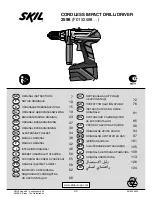
General Safety Rules
1.
For multiple hazards, read and understand the safety instructions before installing, operating,
repairing, maintaining, changing accessories on, or working near the power tool. Failure to do
so can result in serious bodily injury.
2.
Only qualified and trained operators should install, adjust or use the power tool.
3.
Do not modify the power tool. Modifications can reduce the effectiveness of safety measures
and increase the risks to the operator.
4.
Do not discard the safety instructions; give them to the operator.
5.
Do not use the power tool if it has been damaged.
6.
Tools shall be inspected periodically to verify that the ratings and markings required by this part
of ISO 11148 are legibly marked on the tool. The employer/user shall contact the manufacturer
to obtain replacement marking labels when necessary.
Safety Rules and Hazards
Projectile Hazards
1.
Failure of the workpiece, of accessories or even of the inserted tool itself can generate
high-velocity projectiles.
2.
Always wear impact-resistant eye protection during the operation of the power tool. The grade
of protection required should be assessed for each use.
3.
Ensure that the workpiece is securely fixed.
Entanglement Hazards
1.
Entanglement hazards can result in choking, scalping, and/or lacerations if loose clothing,
personal jewellery, neckwear, hair or gloves are not kept away from the tool and accessories.
2.
Gloves can become entangled with the rotating drive, causing severed or broken fingers.
3.
Rotating drive sockets and drive extensions can easily entangle rubber-coated or
metal-reinforced gloves.
4.
Do not wear loose-fitting gloves or gloves with cut or frayed fingers.
5.
Never hold the drive, socket or drive extension.
6.
Keep hands away from rotating drives.
Repetitive Motion Hazards
1.
When using a power tool for, the operator can experience discomfort in the hands, arms,
shoulders, neck, or other parts of the body.
2.
While using a power tool, the operator should adopt a comfortable posture whilst maintaining
secure footing and avoiding awkward or off-balanced postures. The operator should change
posture during extended tasks, which can help avoid discomfort and fatigue.
3.
If the operator experiences symptoms such as persistent or recurring discomfort, pain,
throbbing, aching, tingling, numbness, burning sensations or stiffness, these warning signs
should not be ignored. The operator should tell the employer and consult a qualified health
professional.



























